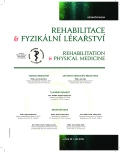Strategies and Mechanisms Affection of Postural Stability
Authors:
M. Hagovská 1; Z. Olekszyová 2
Authors‘ workplace:
Klinika fyziatrie, balneológie a liečebnej rehabilitácie LF UPJŠ, Košice
1; Súkromná psychiatrická ambulancia, Čistá duša, s. r. o., Vysokošpecializovaný odborný ústav geriatrický sv. Lukáša, Košice
2
Published in:
Rehabil. fyz. Lék., 23, 2016, No. 3, pp. 150-156.
Category:
Original Papers
Overview
Objective:
Description of evaluation methods in postural stability, and comparison of several types of balance training programs with cognitive tasks.
Results:
We have found that there are many kinds of balance trainings. All these kinds differ from each other due to the process, strategy, training frequency, in progressivity and the use of various balance aids and the like. Currently, the importance of application of so-called cognitive dual tasks combined with different kinds of physical training is being stressed.
Conclusion:
However, the transfer of the effect of this kind of training in the performance of daily activities and life quality in seniors has not been sufficiently long monitored and confirmed.
Keywords:
balance training, balance aids, postural stability
Sources
1. BERG, K., WOOD - DAPUHINEE,S., WILIAMS, J., MAKI, B.: Measuring Balance in the Eldery: Validation of an Instrument. In Canadian Journal of Public health. 1992, Suppl. 2, č. 1, s. 7-11, ISSN 0008-4263.
2. GURALNIK, J. M., SIMONSICK, E. M., FERRUCCI, L. et.al.: A short physical performance battery assessing lower extremity function: association with self-repoted disability and prediction of mortality and nursing home admission. In J. Gerontol. Biol. Sci. Med. Sci., 49, 1994, s. M85-M94, ISSN 1079-5006.
3. HAGOVSKÁ, M., OLEKSZYOVÁ, Z.: Impact of the combination of cognitive and balance training on gait, fear and risk of falling and quality of life in seniors with mild cognitive impairment. Geriatr Gerontol. Int., 2015, doi: 10.1111/ggi.12593. [Epub ahead of print].
4. HAGOVSKÁ, M., OLEKSZYOVÁ, Z.: Relationships between balance control and cognitive functions, gait speed, and activities of daily living. Gerontol. Geriat, doi 10.1007/s00391-015-0955-3.
5. HALVARSSON, A., OLSSON, E., FARE,´N. E., PETTERSSON, A., STAHLE, A.: Effects of new, individually adjusted, progressive balance group training for elderly people with fear of falling and tend to fall: a randomized controlled trial. In Clinical Rehabilitation., 25, 2011, 11, s. 1021-1031, ISSN 0269-2155.
6. HALVARSSON, A., FRANZEN, E., FARE,´N. E., OLSSON, E., ODDSSON, L., STAHLE, A.: Long-term effects of new progressive group balance training for elderly people with increased risk of falling – a randomized controlled trial. In Clin. Rehabil., 27, 2013, 5, s. 450-458, ISSN 0269-2155,
7. HIYAMIZU, M., MORIOKA, SHOMOTO, A. K., SHIMADA, T.: Effects of dual task balance training on dual task performance in elderly people: a randomized controlled trial. In Clinical Rehabilitation, 26, 2011, 1, s. 58-67, ISSN 0269-2155.
8. HORAK, F., HORAK, F. B., WRISLEY, D. M. et. al. : „The Balance Evaluation Systems Test (BESTest) to differentiate balance deficits“. In Physical Therapy, 89, 2009, 5, s. 484-498, ISSN 0031-9023,
9. CHAMBERLIN, M. E., FULWIDER, B. D., SANDERS, S. L., MEDEIROS, J. M.: Does fear of falling influence spatial and temporal gait parameters in elderly persons beyond changes associated with normal aging? In J. Gerontol. A Biol. Sci. Med. Sci., 60, 2005, 1, s. 1163-1167, ISSN 1079-5006.
10. ODDSSON, L., BOISSY, P., MELZER, I.: How to improve gait and balance function in elderly individuals - compliance with principles of training. In Euro Rev. Aging. Phys. Activity, 4, 2007, 1, s. 15-23, ISSN 1813-7253.
11. PATLA, A. E.: Strategies for dynamic stability during adaptive human locomotion. In IEEE Eng. Med. Bio. Mag., 22, 2003, 1, s. 48-52, ISSN 0739-5175.
12. REIJNDERS, J., V.: Cognitive interventions in healthy older adults and people with mild cognitive impairment: a systematic review. In Ageing Res. Rev., 12, 2013, 1, s. 263-275, ISSN 1568-1637.
13. SHUMWAY-COOK, A., WOOLLACOTT, M. H.: Motor Control. 4 th. ed. Philadephia, Baltimore, 2012, 64 s., ISBN 978-1-60831-018-0.
14. SUTTANON, P., HILL, K. D., SAID, C. M., WILLIAMS, S. B., BYRNE, K. N., LoGIUDICE, D., LAUTENSCHLAGER, N. T.: Feasibility, safety and preliminary evidence of the effectiveness of a home-based exercise programme for older people with Alzheimer’s disease: a pilot randomized controlled trial. In Clin. Rehabil., 27, 2013, 5, s. 427-438, ISSN 1671-5926.
15. SILUSPADOL, P., LUGADE, V., SHUMWAY-COOK, A. et.al.: Training-related changes in dual-task walking performance of eldery persons with balance impairment: a double-blind, randomized controlled trial. In Gait Postrure, 29, 2009, s. 634-639, ISSN 1879-2219.
16. SILUSPADOL, P., SHUMWAY-COOK, A., WOOLLACOTT, M.: Training of balance under single and dual task conditions in older adults with balance impairment: three case reports. In Phys. Ther., 86, 2006, s. 269-281, ISSN 0031-9023.
17. SILUSPADOL, P., SHUMWAY-COOK, A., LUGADE, V. van DONKELAAR, P., CHOU, L. S., MAYR, U., WOOLLACOTT, M. H.: Effects of single-task versus dual-task training on balance performance in older adults: a double-blind, randomized controlled trial. In Arch. Phys. Med. Rehabil., 90, 2009, s. 381-387, ISSN 0003-9993.
18. ŠVORC, P., KUJANÍK, Š., BRAČOKOVÁ, I.: Fyziológie človeka. 2005, s. 242-246, ISBN 80-89061-92-2.
19. TINETTI, M. E.: Performance-oriented assessment of mobility problems in elderly patients. In JAGS, 34, 1986, 1, s. 119-126, ISSN 1532-5415 (Scoring description: PT Bulletin Feb. 10, 1993).
20. WOLF, S. L., CATLIN, P. A., ELLIS, M., LINK, A., MORGAN, B., PIACENTO, A.: Assessing Wolf Motor Function Test as outcome measure for research in patients after stroke. In Stroke., 32, 2001, s. 1635, ISSN 0039-2499.
Labels
Physiotherapist, university degree Rehabilitation Sports medicineArticle was published in
Rehabilitation & Physical Medicine

2016 Issue 3
Most read in this issue
- Hippotherapy and Its Use in Rehabilitation
- Clinical Study of Applied High-induction Electromagnetic Field on Painful Conditions
- Strategies and Mechanisms Affection of Postural Stability
- Functional State of Foot Arches and Deep Stabilization System of Trunk at Girls Racing Sports Aerobics
